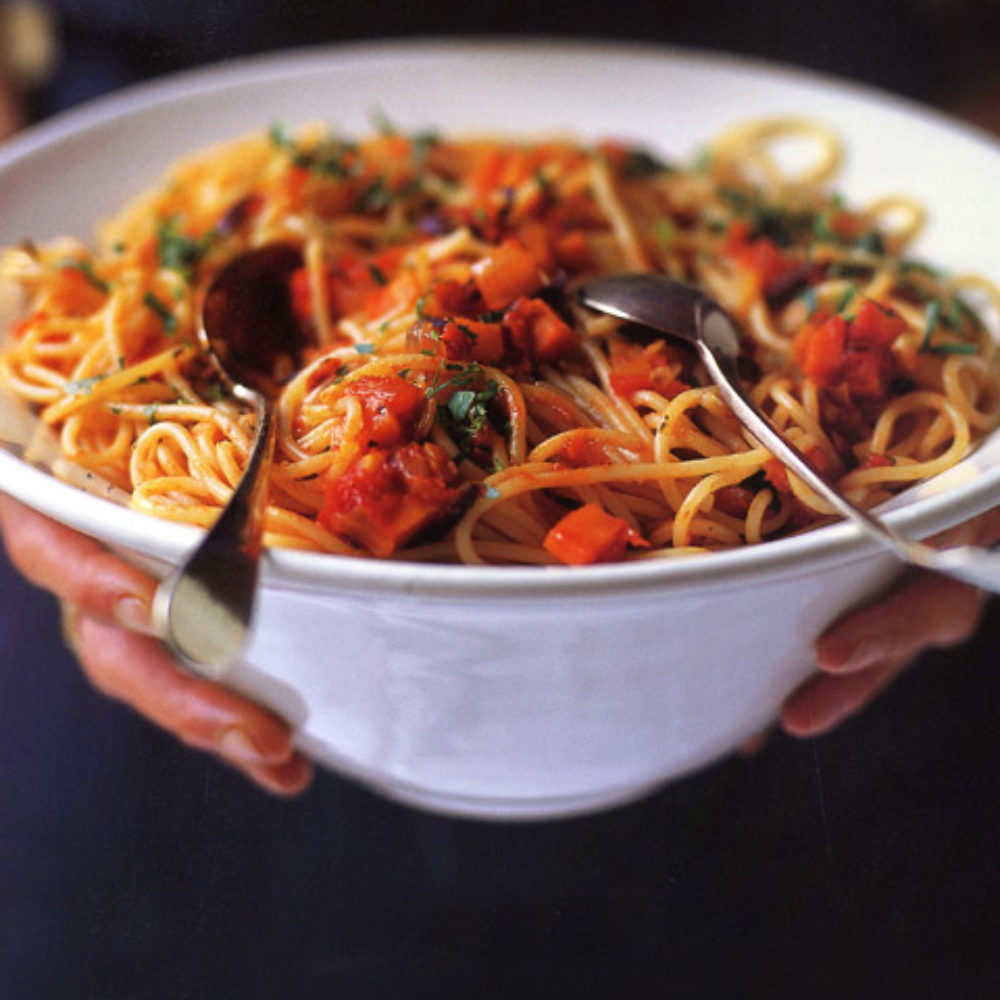This week, I am sharing with you an easy, simple recipe of one of our local chefs, Belinda Jeffery – some of you may have one of her cookbooks on your kitchen shelves already. The recipe is spaghetti with chunky tomato, olive and chilli sauce and is a great one as if some of the ingredients aren’t in season you can easily substitute them for other ingredients that are in season at the time – so this is a year round recipe. In Belinda’s own words “I have to admit that this sauce changes somewhat nearly every time I make it. It depends what’s in the fridge really. If there are no carrots, I just leave them out, and I quite often add a bit more garlic or different herbs according to what’s in the garden. And that’s what I love about it: it’s not one of those dishes that you have to be too fussed about, a bit more or less of anything won’t do any harm”.
I also love this recipe as many of the ingredients can be sourced directly from our wonderful stalls at the market.
Ingredients
- 2 tablespoons extra-virgin olive oil (Byron Spice Palace)
- 2 large onions, finely chopped (Sylva Lining Organics)
- 2 medium-sized carrots, cut into smallish dice (Summit Organics)
- 2 large cloves garlic, finely chopped (Sylva Lining Organics)
- 2 small red chillies, finely chopped (Jumping Red Ant)
- 1 heaped tablespoon of sun-dried tomato pesto (or regular tomato paste)
- 1 x 800g can diced tomatoes
- big pinch of sugar
- sea salt, to taste
- freshly ground black pepper, to taste
- 500g spaghetti (Woodland Valley Farm)
- 150g kalamata olives, pitted and coarsely chopped (Byron Spice Palace)
- large handful of basil leaves, roughly torn (Summit Organics or Johny’s Garden)
- small basil leaves (Summit Organics or Johny’s Garden)
- freshly grated parmesan cheese (Nimbin Valley Dairy or Cheeses Loves You)
- rocket leaves (optional) (Summit Organics)
- ricotta (optional) (Nimbin Valley Dairy or Cheeses Loves You)
Method
Step 1: Heat the oil in a large frying pan over medium-high heat. Tip in the onions and carrots and cook them, stirring occasionally, for 10 minutes, or until they’re soft and golden. Add the garlic and chilli and give them a good stir. Let it all cook another 2-3 minutes, then mix in the tomato pesto or paste. Cook it for 1 minute, stirring all the while, until it smells really fragrant. Pour in the tomatoes and their juices. Sprinkle in the sugar and some salt and pepper. Bring the sauce to the boil, then turn down the heat to low and leave it to bubble away gently for 20-25 minutes, stirring occasionally, until it’s quite thick. Turn off the heat.
Step 2: To cook the pasta, bring a large pot of water to a rolling boil. Add a tablespoon or so of salt to the water, then add the spaghetti and give it a good stir. Cover the pan. As soon as the water returns to the boil, remove the lid and cook the spaghetti until it’s al dente. The easiest way to check this is to fish out a strand and take a bite…it should still be a tiny bit firm in the middle.
Step 3: While the pasta is cooking, reheat the sauce and stir in the olives and basil. Taste it and add more salt and pepper if necessary. As soon as the spaghetti is cooked, drain it well in a colander, retaining a little of the cooking water for thinning the sauce if necessary. Give the spaghetti a good shake and tip it into the sauce. Mix the sauce and pasta really well together so the strands are thoroughly coated. Divide the pasta between warm bowls. Scatter the top with some basil leaves and serve it with parmesan.
Step 4: a variation, and to make it a bit more substantial, I quite often put some torn rocket leaves and a scoop of ricotta into each bowl before adding the pasta. It softens the flavour of the sauce a bit and makes it slightly creamy.
Step 5: Chopping Olives – Slicing up olives can be a bit of a fiddle. Often you end up dealing with them like mangoes – cutting off the cheeks then the sides – but it is a bit tedious. However, with olives like kalamatas, where the flesh doesn’t cling too tightly to the stone, there’s a faster way to do this. Just squash the olive by pressing down on it with the flat of a large chef’s knife. The flesh usually pulls away from the stone easily and then you can chop it as you like.
*Recipe and photo can be found at the following website: https://belindajeffery.com.au/recipe/spaghetti-with-chunky-tomato-olive-and-chilli-sauce/

